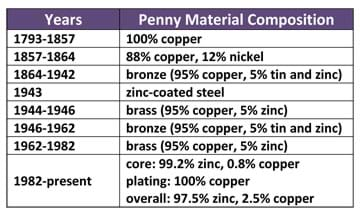(Solid-Liquid Interactions)
This activity is composed of three parts:
Part 1: Property Investigation
Part 2: Myth Busters' Investigation
Part 3: Become a Design Engineer
The activity is designed to be completed during three 55-minute periods over three days. Some materials can be re-used across the three days, some materials are used on only one or two days, and other materials will be used up (such as test liquids).
Overall Activity Materials

Each group needs:
- 4 copper pennies (post-1982, see Table 1; need one penny for each liquid being tested)
-diameter: 0.75 inches (19.05 mm)
-thickness: 0.75 inches (19.05 mm)
-weight: 2.5 g
- 4 plastic "coins" (same size as a standard penny, available at hardware stores as an item put under glass placed on table tops, need one for every liquid being tested)
- 3 liquids (minimum), ~50-60 ml for each group (such as pure distilled water, ethanol, hydrogen peroxide, vegetable oil, salt water mixture, soapy water mixture, any type of soda/pop; different concentrations of salt or soap yield different results; the goal is to have liquids that respond differently when in contact with the penny and coin surfaces; choose liquids that have very different surface tensions; refer to Table 2)
![A table shows surface tension (in dyne/cm) of various liquids: acetone (23.7), ethanol (22.27), ethanol [40% mass + water] (29.63), ethanol [11.1% mass + water] (46.03), isopropanol (21.7), sucrose [55% mass + water] (76.45), and water (72). A table shows surface tension (in dyne/cm) of various liquids: acetone (23.7), ethanol (22.27), ethanol [40% mass + water] (29.63), ethanol [11.1% mass + water] (46.03), isopropanol (21.7), sucrose [55% mass + water] (76.45), and water (72).](/content/wsu_/activities/wsu_penny/table2newweb.jpg)
- 3 x 50-ml glass beakers, one for each liquid being tested
- 3 disposable eye droppers or pipettes, need one for each liquid being tested
- ruler
- calculator
- plastic weighing dish
- graduated cylinder (or graduated pipette)
To share with entire class:
- paper towels
- cotton balls (or paper towels), to clean pennies and coins after testing
- isopropanol, to clean pennies and coins after testing
- de-ionized water, for rinsing
- waste container, for used liquids
- electronic scale, to measure weights of pennies and average liquid drop weights (depending on class size, you may want multiple scales)
- 3 surface treatment suggestions (choose minimum of three):
-hair spray (1 can)
-Pam cooking spray (1 can, composed of canola oil)
-fast-drying spray adhesive (1 can)
-waterproof spray paint (1 can)
-medium- to high-grit sandpaper (1 package)
-aluminum foil (2 rolls, depending on size)
-paraffin wax paper ~ stretchy (1 box)
- hair dryer, or other method of drying wet surface treatments
Part 1 Materials
Each group needs:
- Part 1 Worksheet
- 3 x 50-ml beakers
- graduated cylinder (or graduate pipette)
- calculator
- 32 ml of each liquid
- plastic dish
- 3 plastic pipettes
- 4 copper pennies
- 4 plastic coins

To share with the entire class:
- electronic scale
- de-ionized water
- waste container
- paper towels
- cotton balls (or paper towels), to clean pennies and coins after testing
- isopropanol, to clean pennies and coins after testing
Part 2 Materials
Each group needs:
- Part 2 Worksheet
- Student Testing Page
- 3 x 50-ml beakers
- calculator
- ruler
- 16 ml of each liquid
- 3 plastic pipettes
- 3 copper pennies
- 3 plastic coins
To share with the entire class:
- electronic scale
- waste container
- paper towels
- cotton balls (or paper towels), to clean pennies and coins after testing
- isopropanol, to clean pennies and coins after testing
- de-ionized water, for rinsing
Part 3 Materials:
Each group needs:
- Part 3 Worksheet
- 50-ml beaker
- 2 copper pennies
- 2 plastic coins
- 2 plastic pipettes
- calculator
- ruler
To share with the entire class:
- blank printer paper
- waste container
- surface treatment materials
- test liquids ~10 ml of each per group
- hair dryer, or other method of drying wet surface treatments
- paper towels
- cotton balls (or paper towels), to clean pennies and coins after testing
- Isopropanol, to clean pennies and coins after testing
- de-ionized water, for rinsing
- scissors, for cutting surface treatment materials
Note: In this activity, "penny" refers to the copper penny, and "coin" refers to the coin-shaped plastic disk.
 https://www.teachengineering.org/activities/view/wsu_penny_activity1
https://www.teachengineering.org/activities/view/wsu_penny_activity1